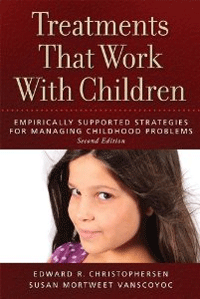“Treatments That Work With Children: Empirically Supported Strategies for Managing Childhood Problems”

“Treatments That Work With Children: Empirically Supported Strategies for Managing Childhood Problems”
By Edward R. Christophersen and Susan Mortweet Vanscoyoc
American Psychological Association
Washington, D.C., 2013
Book has great multidisciplinary appeal
Reviewed by James K. Luiselli, Ed.D., ABPP, BCBA-D
The purpose of this book is twofold, first, to introduce primary care physicians to the services that psychologists offer in treating childhood problems and second, to provide psychologists with a contemporary review of evidence-based and empirically supported procedures. This is a second edition of the book in which the authors focus on problem behaviors that “are most commonly addressed by pediatric mental health clinicians and have procedures that have been evaluated in formal outcome studies.”
The book features chapters about disruptive behavior disorders, anxiety and depressive disorders, tics and habit disorders, sleep problems, nocturnal enuresis, encopresis, pain and adherence to medical regimens. This list is certainly inclusive of problems typically seen in pediatric medical settings. Additional topics such as feeding disorders and a summary chapter that advises about the future objectives and direction of evidence-based research might be considered for future editions.
Each chapter in the book has a similar format, starting with a clinical description of the particular childhood problem according to DSM-IV-TR criteria. It should be noted that the book pre-dated publication of DSM-5 although when applicable, the authors discuss how proposed changes in the latter volume will influence diagnostic classification. On this point, it may be fruitful to have the DSM-5 at hand when reading the book.
After introducing diagnostic and clinical features, the chapters follow with information about prevalence and contributing factors. This etiological perspective properly embraces individual, biological, and family influences, with good representation of epidemiological studies. In a final section, each chapter covers assessment strategies and then intervention methods, including pharmacotherapy. The standardized format of diagnosis, prevalence, assessment and intervention with each childhood problem is useful when moving among the chapters, discerning differences and commonalities and integrating the many practice recommendations.
The authors propose that their book can serve as a reference source and training tool for pediatric primary care physicians. They also intended the book to be “clinician friendly” and an easily accessible resource for psychologists. Of course, getting the book in the hands of pediatricians is a challenge but an endeavor that will reap rewards and improve child care. I wonder, in fact, whether it would have been instructive to have one or more chapters about how psychologists can disseminate evidence-based research findings and consult accordingly to medical professionals.
Noting the emphasis on research-to-practice translation, this book excels in giving the reader insightful analysis of strategies that have widespread application and documented success. The treatment orientation is grounded in behavioral psychology, applied behavior analysis and cognitive-behavioral therapy, so the book is rich with data and experimentally derived clinical methods. Another positive feature is the inclusion of recording forms and rating scales for evaluating intervention effects, verifying procedural fidelity and perhaps most importantly, reporting results to referring physicians that have established a collaborative relationship with psychologists.
“Treatments That Work With Children” is a strong contribution to the child clinical psychology literature and as well, should have an impact in the fields of pediatric behavioral medicine and health psychology. If you are a psychologist working in a hospital or affiliated with pediatric clinics, please refer the book to your physician colleagues. Among many books about childhood problems, this one stands out because it has great multidisciplinary appeal and commitment to a scientist-practitioner model of professional training and practice.
James K. Luiselli, Ed.D., ABPP, BCBA-D, is senior vice president, applied research, clinical training and peer review at the May Institute in Norwood, Mass.
Learn more about the book: Treatments that Work with Children: Empirically Supported Strategies for Managing Childhood Problems
